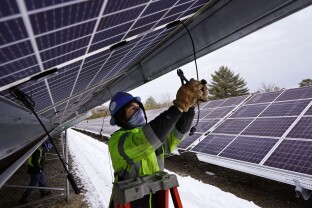Clean energy jobs increased at about double the rate of overall employment in 2023, with Republican-led states seeing some of the highest rates of growth, the Biden administration announced Wednesday.
The incentives from the Inflation Reduction Act and infrastructure bill, combined with the first serious spike in U.S. electricity demand in decades, appear to have buoyed the energy industry, even as hiring slowed in many other sectors of the economy, according to this year’s new Department of Energy employment report.
The new energy jobs numbers reflect the investment data and tax data: The energy economy is continuing to undergo a significant transformation, even as oil and gas remain important. Consumers and businesses have invested about $493 billion in the clean economy over the first two years of the IRA, and that has translated to more than half of all new energy sector jobs going toward clean energy. In the electricity industry, that number is more like 80%, according to the new data.
More than 50% of the investments from the IRA have gone to Republican districts. And the job numbers show a similar trend.
Idaho, Texas and New Mexico led the country in clean energy job growth, increasing employment at rates between about 6% and 8%. In these three states, many of the new clean energy jobs over the last year came from areas explicitly incentivized in the IRA: In Texas, energy efficiency, solar and manufacturing were key growth contributors; in Idaho, solar, biomass and ethanol; and in New Mexico, energy efficiency and construction.
Despite the strong job numbers, most voters say they know very little about the IRA and its effects, and Vice President Kamala Harris’ campaign rarely focuses on climate or the environment on the campaign trail.
On a press call announcing this year’s numbers, White House climate adviser Ali Zaidi repeatedly emphasized unionization rates in clean energy. Unions have been somewhat skeptical of the clean energy transition, given that many of these new sectors don’t have a strong union history, and the transition could lead to a decline in jobs with traditionally strong union representation.
“The storyline around union density here is just so powerful,” Zaidi said on the call. The unionization rates for clean energy in 2023 are just slightly higher than the average for the energy industry (about 1.4% above).
But overall, the biggest story in the numbers was in Texas: The country’s largest oil and gas producer now claims the total greatest number of energy jobs in the country, the second greatest number of clean energy jobs (after California) and one of the highest growth rates in clean energy jobs for several years running.
Despite its fossil fuel dependence, in many ways, Texas has become a clean energy model for the rest of the country. The state has surpassed the rest of the country — including California, the longtime solar leader — in both wind and solar utility-scale generation and is now on track to do the same for battery storage.
—
Anna Kramer is a reporter at NOTUS.
Sign in
Log into your free account with your email. Don’t have one?
Check your email for a one-time code.
We sent a 4-digit code to . Enter the pin to confirm your account.
New code will be available in 1:00
Let’s try this again.
We encountered an error with the passcode sent to . Please reenter your email.


